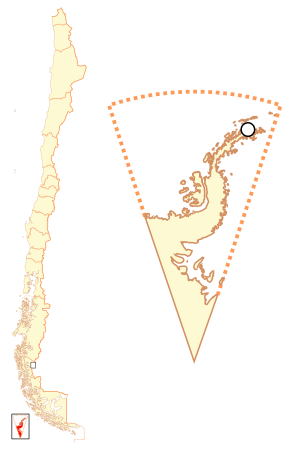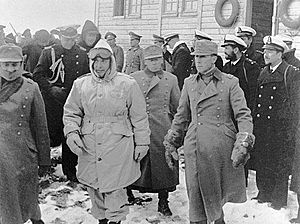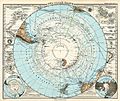Chilean Antarctic Territory facts for kids
Quick facts for kids
Chilean Antarctic Territory
Territorio Chileno Antártico
|
|||
|---|---|---|---|
|
|||
 |
|||
| Country | |||
| Region | |||
| Province | Antártica Chilena | ||
| Commune | Antártica | ||
| Claimed | November 6, 1940 | ||
| Area | |||
| • Total | 1,250,257.6 km2 (482,727.2 sq mi) | ||
| Population
(2012 Census)
|
|||
| • Total | 115 | ||
| • Density | 9.20×10−5/km2 (0.0002382/sq mi) | ||
| • Urban | 0 | ||
| • Rural | 115 | ||
| Sex | |||
| • Men | 100 | ||
| • Women | 15 | ||
| Time zone | UTC-3 | ||
| Area code(s) | 56 + 61 | ||
| Capital | Villa Las Estrellas | ||
| Currency | Chilean Peso | ||
| Website | http://www.inach.cl/ | ||
The Chilean Antarctic Territory is a part of Antarctica that Chile says belongs to it. Chile made this claim in 1940. Other countries like Argentina and the United Kingdom also claim parts of Antarctica that overlap with Chile's claim.
In Chile, this special territory is managed by a local area called Antártica. It's part of the Antártica Chilena Province, which is in the Magallanes y la Antártica Chilena Region. The Antártica area was set up on July 11, 1961. It used to be part of the Magallanes Province. Then, in 1975, the Antártica Chilena Province was created. Now, the Antártica area is managed from Puerto Williams, which is the capital of that province.
The Antarctic Treaty is an international agreement. It puts all claims to land in Antarctica on hold. This means that while countries can claim land, they agree not to act on those claims. They focus instead on scientific research and peaceful activities.
Exploring Chilean Antarctic Bases
Chile has several important bases in its claimed Antarctic territory. These bases are used for scientific research and to support people living and working there.
Here is a list of the main Chilean Antarctic Bases:
| Name | Country | Location | Type |
|---|---|---|---|
| Base Presidente Eduardo Frei Montalva | King George Island | P | |
| Base General Bernardo O'Higgins Riquelme | Antarctic Peninsula | P | |
| Base Capitán Arturo Prat | Greenwich Island | P | |
| Base Profesor Julio Escudero | King George Island | P | |
| Estación Polar Científica Conjunta "Glaciar Unión" | Union Glacier | S | |
| Base Yelcho | Doumer Island | S | |
| Base Doctor Guillermo Mann | Livingston Island | S | |
| Base Presidente Gabriel González Videla | Paradise Bay | S | |
| Refugio Julio Ripamonti | Ardley Island | S | |
| Refugio Luis Risopatrón | Robert Island | S | |
| Refugio Collins | Collins Bay | S |
- P: Permanent bases are open all year round. People live and work there even in the harsh winter.
- S: Seasonal bases are open only during the Austral Summer. This is when the weather is milder and more research can be done.
Villa Las Estrellas is the only place in a Chilean base where families and civilians live. There is another similar settlement at Argentina's Esperanza Base.
The only permanent Chilean base on the Antarctic Peninsula is Base General Bernardo O'Higgins Riquelme. It has been operating since February 18, 1948. It is located at Puerto Covadonga.
Images for kids
-
Map of the three areas dividing the Chilean territory: In blue: Continental Chile In red: Insular Chile In green: Antarctic Chile
-
Penguins near President Gabriel González Videla Base (1957)
-
Pedro Aguirre Cerda Base (Closed Today), in Deception Island, 1958.
-
Chilean patrol Lientur in Cooper Mine, Robert Island, 1958.
-
Panoramic view of Villa Las Estrellas in winter.
See also
 In Spanish: Territorio Chileno Antártico para niños
In Spanish: Territorio Chileno Antártico para niños















